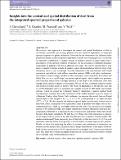Files in this item
Insights into the content and spatial distribution of dust from the integrated spectral properties of galaxies
Item metadata
| dc.contributor.author | Chevallard, J. | |
| dc.contributor.author | Charlot, S. | |
| dc.contributor.author | Wandelt, B. | |
| dc.contributor.author | Wild, Vivienne | |
| dc.date.accessioned | 2014-08-13T10:31:01Z | |
| dc.date.available | 2014-08-13T10:31:01Z | |
| dc.date.issued | 2013-07-01 | |
| dc.identifier | 68897779 | |
| dc.identifier | 650f26f3-c12d-457d-adf2-63b8221b2442 | |
| dc.identifier | 000320455800018 | |
| dc.identifier | 84879595172 | |
| dc.identifier.citation | Chevallard , J , Charlot , S , Wandelt , B & Wild , V 2013 , ' Insights into the content and spatial distribution of dust from the integrated spectral properties of galaxies ' , Monthly Notices of the Royal Astronomical Society , vol. 432 , no. 3 , pp. 2061-2091 . https://doi.org/10.1093/mnras/stt523 | en |
| dc.identifier.issn | 0035-8711 | |
| dc.identifier.uri | https://hdl.handle.net/10023/5133 | |
| dc.description | JC and SC acknowledge the support of the European Commission through the Marie Curie Initial Training Network ELIXIR under contract PITN-GA-2008-214227. BW acknowledges the support of the NSF via the grant AST 07-08849 and of the Agence Nationale de la Recherche via the Chaire d’Excellence ANR-10-CEXC-004-01. VW acknowledges the support of the European Research Council via a Starting Grant (SEDMorph, PI: Wild) and an Advanced Grant (PI: James Dunlop). | en |
| dc.description.abstract | We present a new approach to investigate the content and spatial distribution of dust in structurally unresolved star-forming galaxies from the observed dependence of integrated spectral properties on galaxy inclination. Motivated by the observation that different stellar populations reside in different spatial components of nearby star-forming galaxies, we develop an innovative combination of generic models of radiative transfer in dusty media with a prescription for the spectral evolution of galaxies, via the association of different geometric components of galaxies with stars in different age ranges. We start by showing that a wide range of radiative transfer models all predict a quasi-universal relation between slope of the attenuation curve at any wavelength, from the ultraviolet to the near-infrared, and V-band attenuation optical depth in the diffuse interstellar medium (ISM), at all galaxy inclinations. This relation predicts steeper (shallower) dust attenuation curves than both the Calzetti and Milky Way curves at small (large) attenuation optical depths, which implies that geometry and orientation effects have a stronger influence on the shape of the attenuation curve than changes in the optical properties of dust grains. We use our new, combined radiative transfer and spectral evolution model to interpret the observed dependence of the Hα/Hβ ratio and ugrizYJH attenuation curve on inclination in a sample of about 23 000 nearby star-forming galaxies, which we correct for systematic biases by developing a general method based on importance sampling. From the exploration of the model parameter space by means of a Bayesian Markov chain Monte Carlo technique, we measure the central face-on B-band optical depth of this sample to be τB⊥ ≈ 1.8 ± 0.2 (corresponding to an angle-averaged ⟨τ^ISMV⟩θ≈0.3). We also quantify the enhanced optical depth towards newly formed stars in their birth clouds, finding this to be significantly larger in galaxies with bulges than in disc-dominated galaxies, while τB⊥ is roughly similar in both cases. This can arise if, for example, galaxies with significant bulges have higher central star formation efficiencies than their discdominated counterparts at a fixed specific star formation rate, and dustier stellar birth clouds because of the higher metallicity. We find that over 80 per cent of the attenuation in galaxies in our sample is characteristic of that affecting thin-disc stars in radiative transfer models. The median unattenuated V-band luminosity ratio of thick-disc to thin-disc stars is 0.1-0.2, in good agreement with the results from spatially resolved studies of nearby edge-on disc galaxies. Finally, we show that neglecting the effect of geometry and orientation on attenuation can severely bias the interpretation of galaxy spectral energy distributions, as the impact on broadband colours can reach up to 0.3-0.4 mag at optical wavelengths and 0.1 mag at near-infrared ones. This paper also contains an original application of Gaussian random processes to extend the wavelength range of dust attenuation curves. | |
| dc.format.extent | 31 | |
| dc.format.extent | 3980381 | |
| dc.language.iso | eng | |
| dc.relation.ispartof | Monthly Notices of the Royal Astronomical Society | en |
| dc.subject | Radiative transfer | en |
| dc.subject | Dust, extinction | en |
| dc.subject | Galaxies: general | en |
| dc.subject | Galaxies: ISM | en |
| dc.subject | Star-forming galaxies | en |
| dc.subject | Active galactic nuclei | en |
| dc.subject | Small-magellanic-cloud | en |
| dc.subject | Digital Sky Survey | en |
| dc.subject | Chain Monte-Carlo | en |
| dc.subject | Herschel Reference Survey | en |
| dc.subject | Giant molecular clouds | en |
| dc.subject | Initial mass function | en |
| dc.subject | On disk galaxies | en |
| dc.subject | Spiral galaxies | en |
| dc.subject | QB Astronomy | en |
| dc.subject.lcc | QB | en |
| dc.title | Insights into the content and spatial distribution of dust from the integrated spectral properties of galaxies | en |
| dc.type | Journal article | en |
| dc.contributor.sponsor | Science & Technology Facilities Council | en |
| dc.contributor.institution | University of St Andrews. School of Physics and Astronomy | en |
| dc.identifier.doi | https://doi.org/10.1093/mnras/stt523 | |
| dc.description.status | Peer reviewed | en |
| dc.identifier.grantnumber | ST/J001651/1 | en |
This item appears in the following Collection(s)
Items in the St Andrews Research Repository are protected by copyright, with all rights reserved, unless otherwise indicated.

